Throughout almost the entire history of the formation of society, girls paid special attention to various embroideries. At first, only a wealthy person could afford to apply a drawing to a product. However, after some time, embroideries entered into the everyday life of different strata of the population. Each country has its own history of the formation of this art.
- Peculiarities of embroidery in different parts of Russia
- Peculiarities of Southerners
- Northern Traditions
- Peculiarities of perception of fine art
- History of satin stitch embroidery
- Old Russian façade and gold embroidery
- Ornaments of the Slavic peoples and their designation
- Embroidery in Russian folk costume
- Krestetskaya stitch
- Features of the technique
- Basic rules for choosing a pattern
Peculiarities of embroidery in different parts of Russia
Every corner of Russia, city, village has its own distinctive features of creating a design on things.
For example:
- In Chuvashia, 3 main colors of thread are used: black, red, white. Each has its own meaning. Red is a symbol of striving for something new, white speaks of purity, innocence, black is used to create a frame. The peculiarity is that special devices are not used to make the work easier during embroidery.
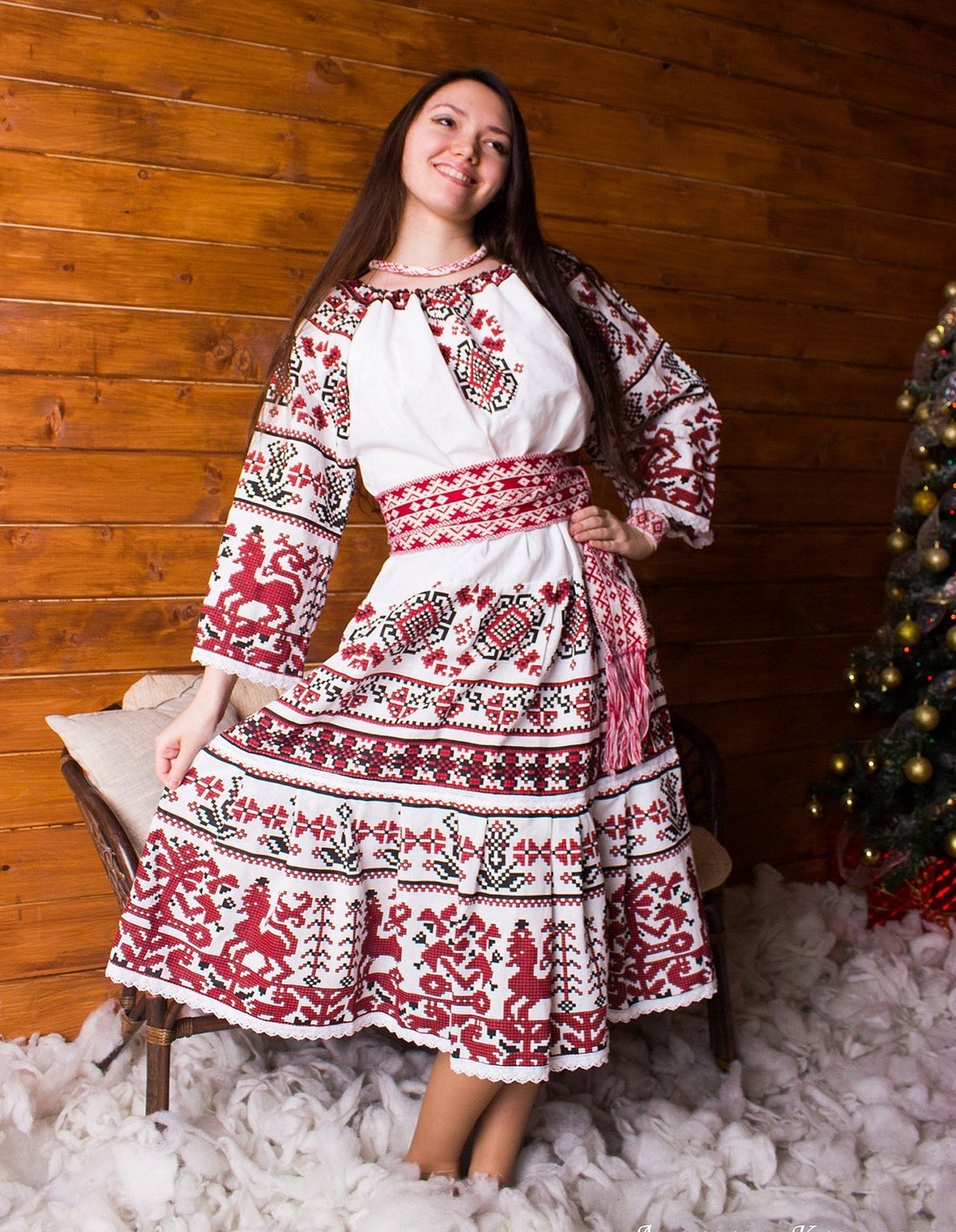
- It is worth mentioning that Slavic embroidery patterns are built mainly on geometric figures. Since the craftswoman dyed the threads herself, the process took a lot of time and was quite labor-intensive.
- In Karelia, the pattern most often had a religious meaning. The ornament is embroidered with red thread on white fabric. The center of the composition is animals and plants. It is extremely popular in Russia and Europe.
- In Mari El, red thread is used for embroidery on homespun material. Patterns: geometric figures, plants, animals. Trees had a special meaning - protection for the family.
- Tarusa technique - linen thread is used, and there is a special technique, white line and colored interweaving. Trees and plants are embroidered on things, which form pictures as a result. The peculiarity is the absence of the reverse side. The technique is also known for embroidering a picture on white fabric with white thread.
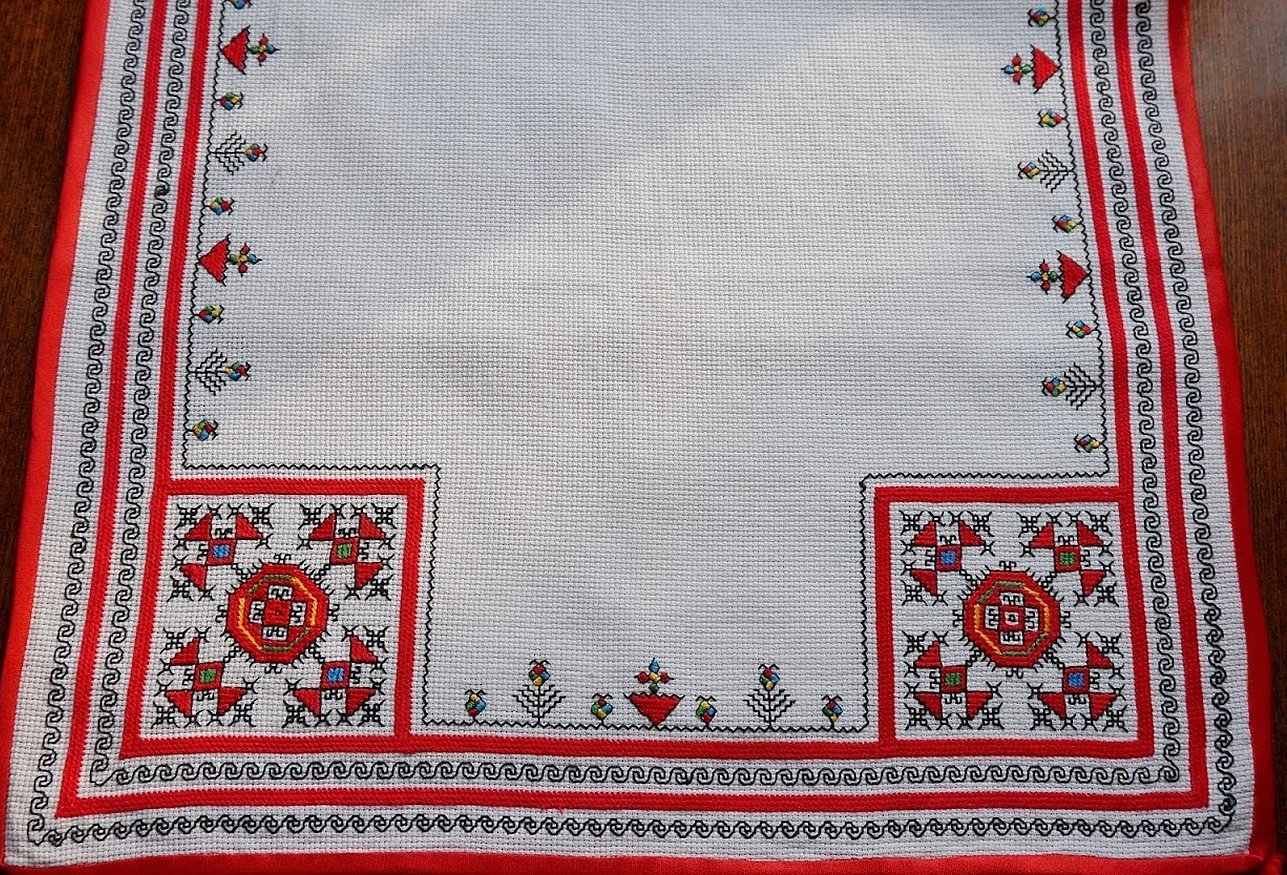
Peculiarities of Southerners
The southern part of Russia is characterized by the presence of geometric patterns in embroidery. In the Voronezh, Tambov, Oryol, Kursk, Penza regions, craftswomen embroidered with white lines, crosses, etc.

The most common are: counted satin stitch, colored interlace. The key element of both embroideries is the use of a semi-transparent fabric under the base.
Additional information! The presence of such embroidery on clothing was evidence of a family’s high level of income.
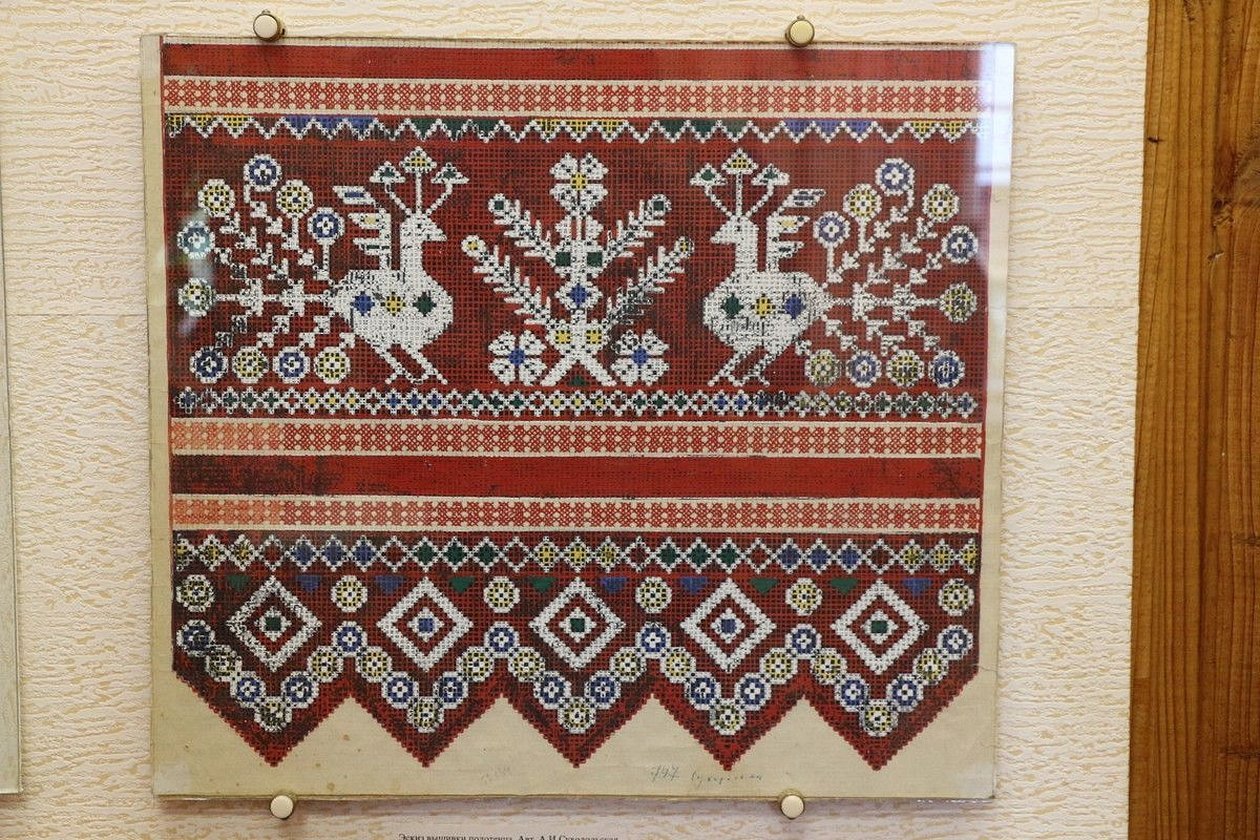
Color features of the areas:
- Ryazan is characterized by blue ornamentation;
- In Smolensk embroideries, lemon, orange, red, and white colors on a gold background are most often found;
- Tula and Kaluga patterns are characterized by a red and white color scheme, interspersed with blue, light blue, green, and yellow inserts;
- Kaliningrad is characterized by the use of a crimson background with a pattern of scarlet, white, green, and gold thread.
Important! Russian embroidery is one of the most developed arts in the creativity of the people. The main geometric shape is a rhombus, a square. They are embroidered with a protrusion in the corners, diagonals, spirals. The material is silk thread.
Northern Traditions
In the Karelian ASSR, Vologda, Arkhangelsk, and Leningrad, the satin stitch technique, the use of oblique stitches, and painting are especially popular.
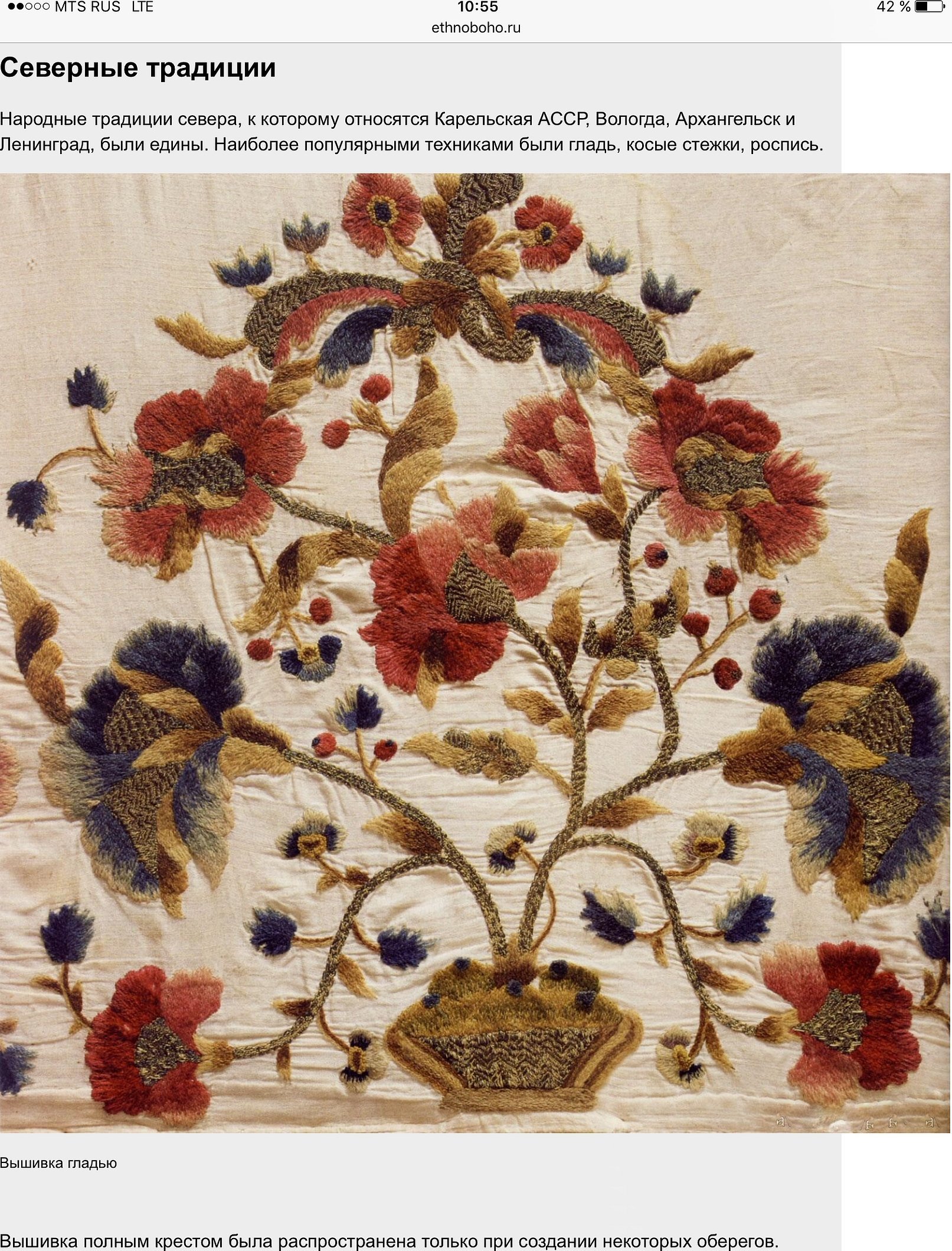
The technique of full cross embroidery was used to decorate amulets.
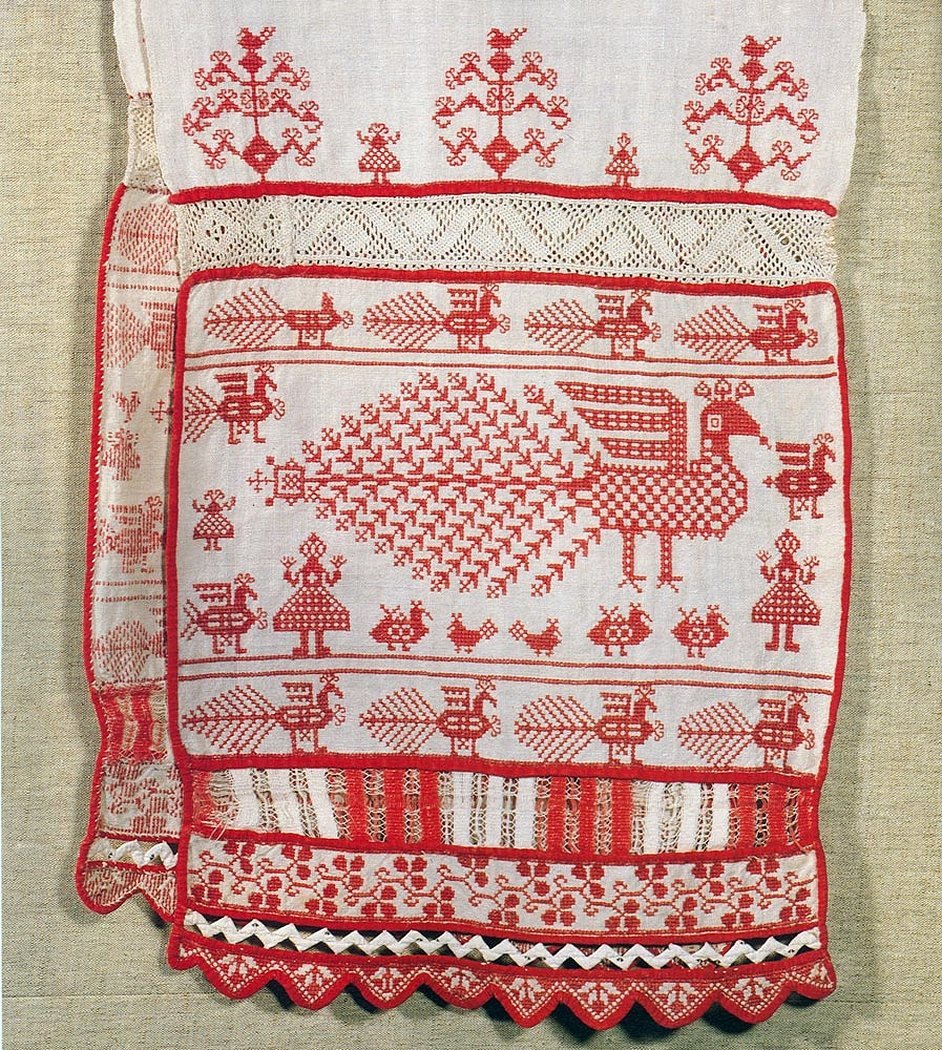
Half cross stitch is a type of edging, the basis of a popular type of painting. Using small stitches of bright colors to create bright patterns. After creating the edging, the interior space is filled with various types of decorative stitches.
The white stitching on the product looks elegant and attractive. It is based on the use of sparse, slightly translucent fabric. The presence of a dense snow-white plot on the item showed the status and high level of family income.
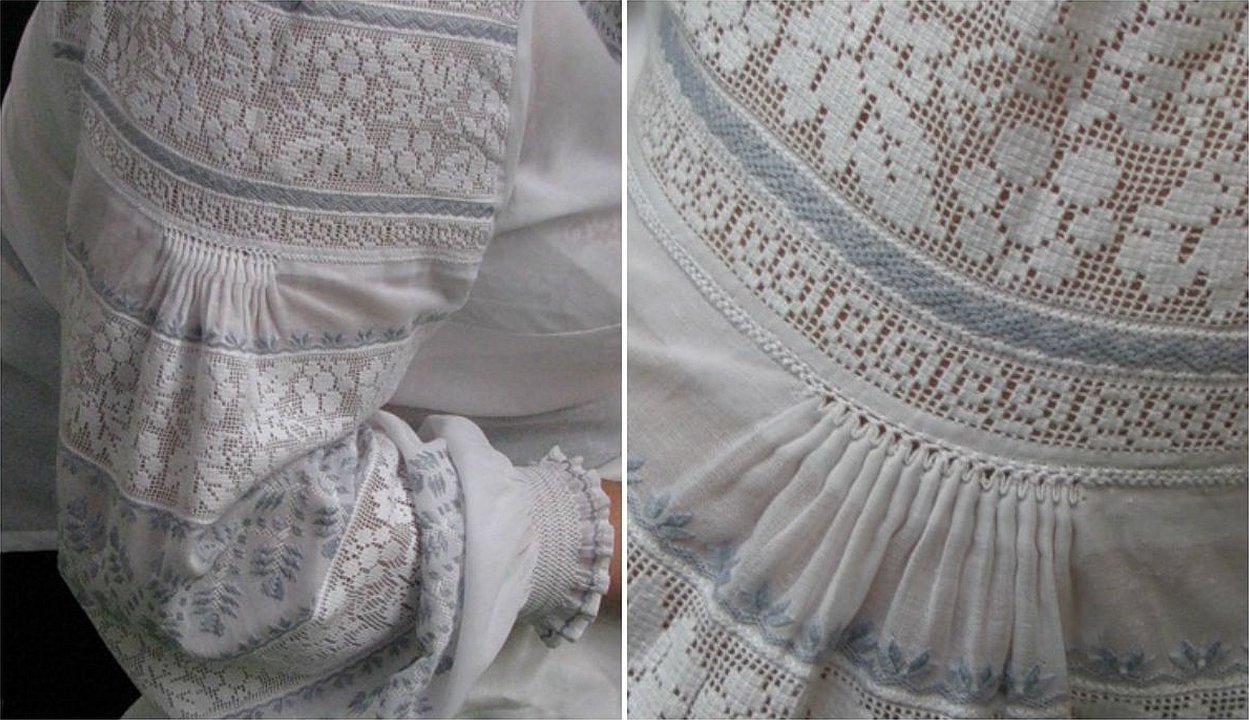
Peculiarities of perception of fine art
Ornament is perceived by a person as part of fine art. At different times, patterns on clothes were perceived differently. Previously, they showed a person's belonging to a class, level of wealth. Also, the ornament indicates the geographical location of the owner of the thing.
Nowadays, the presence of embroidery on a thing shows the aesthetic component of the image. Clothing motifs with embroidery appear every year at fashion shows.
Using the history of satin stitch embroidery as an example, we can trace the development of society's perception of this type of clothing decoration.
History of satin stitch embroidery
Satin stitch embroidery is the use of the correct type of lines. The result is a pattern of shining, shiny threads. A person can admire such an ornament for a long time. The first such embroidery appeared about 2000 years ago.
The technique originated in China in the 6th century BC, at which time the inhabitants belonging to the upper class were fond of decorating things with embroidery. Then a similar technique was used in Japan.
Please note! Looks especially good on silk fabric.
Then, as a result of the emergence and development of the Great Silk Road, the technique gained popularity in European countries. At that time, the fashion for unusual things was especially strong, so embroidery quickly spread across the continent.
At this time, embroidery became known in Rus'. At the same time, fabrics and opportunities for creating ornaments improved. Most often, patterns were used repeatedly, passed on from generation to generation.
In modern society, diagrams are freely available on the Internet.
Peculiarities:
- Both a master and a beginner can do it.
- Simple creation technique.
- A wide range of species.
This ornament is considered one of the main types of art. If the rules for performing stitches are followed correctly, the craftswoman will see excellent embroidery as a result. However, creating a pattern requires attentiveness, perseverance, and concentration on the task.
This version of embroidery has come a long way, adapting, changing, but retaining the basis - the presence of the radiance of the work.
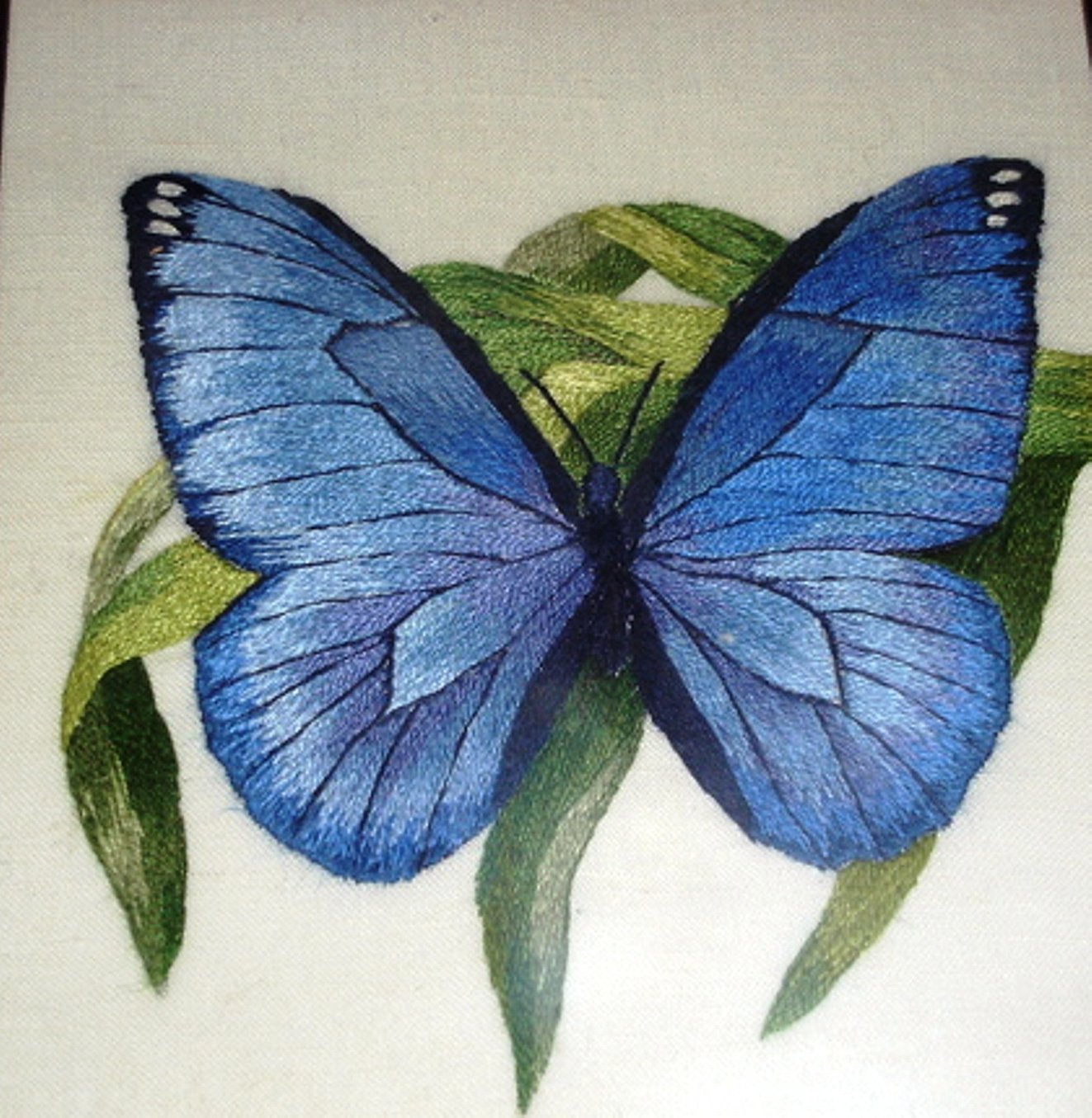
Old Russian façade and gold embroidery
This type of embroidery has an ecclesiastical origin. The legend about the life of the Mother of God says that she had to create a curtain for the temple of the Lord from purple and crimson.
Facial embroidery is a type of icon painting that appeared with the birth of Christianity in Rus'. It is done with colored threads. It was formed under the influence of Byzantium.
Gold embroidery also developed in Byzantium. In Kyiv in the 11th century, a school of gold embroidery appeared at a monastery, where lessons were held. In the 15th century, workshops of queens began to appear, where craftswomen honed their skills. The beginning of the 17th century was marked by rivalry between the workshops of famous people and merchants.
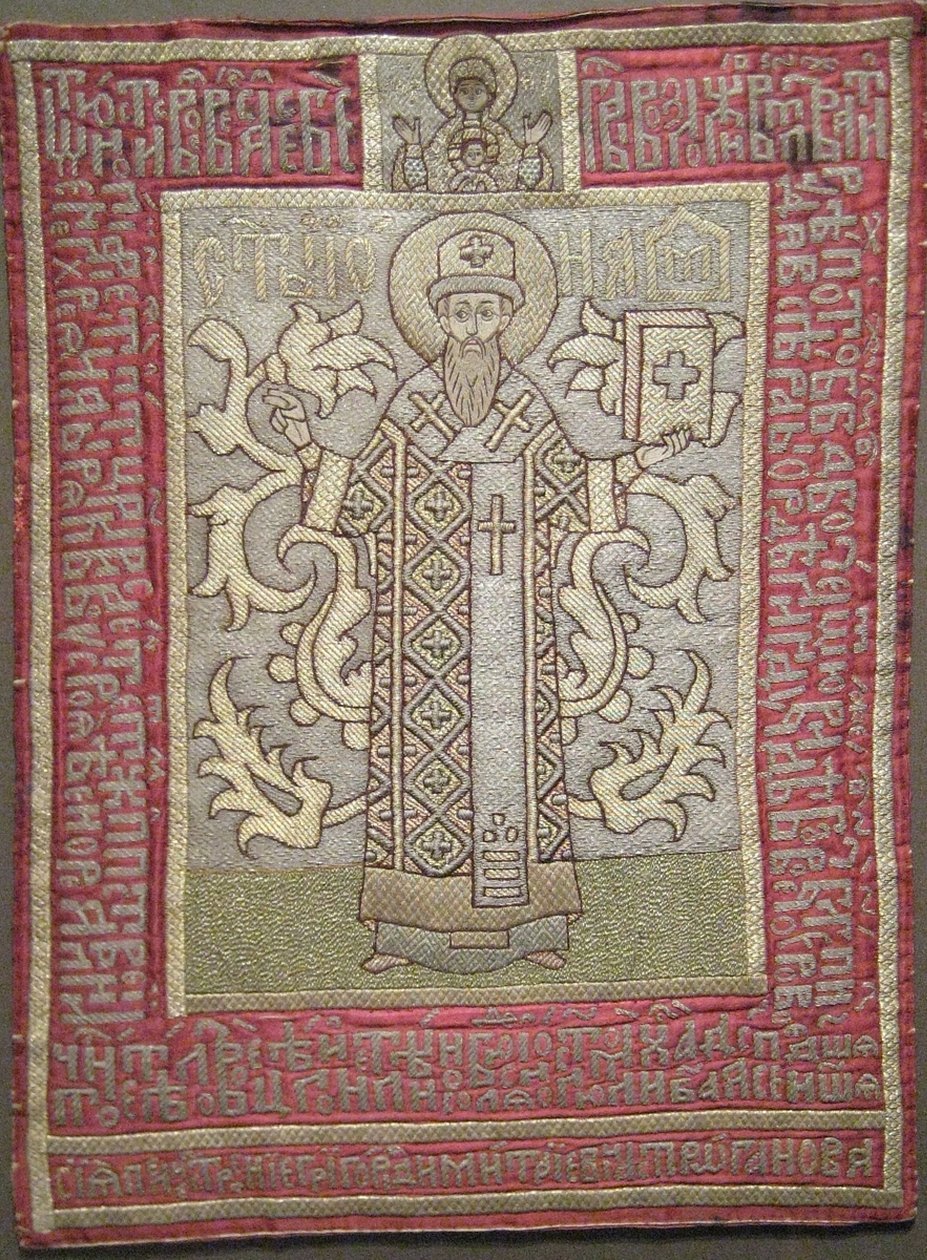
These sewing options constitute the sacred part of the temple, as do the frescoes. They have a certain symbolism of the presence of the deity.
At present, the main task of the masters is to preserve the traditions of ancient art, achieve the level of a master, and adhere to church canons in their work.
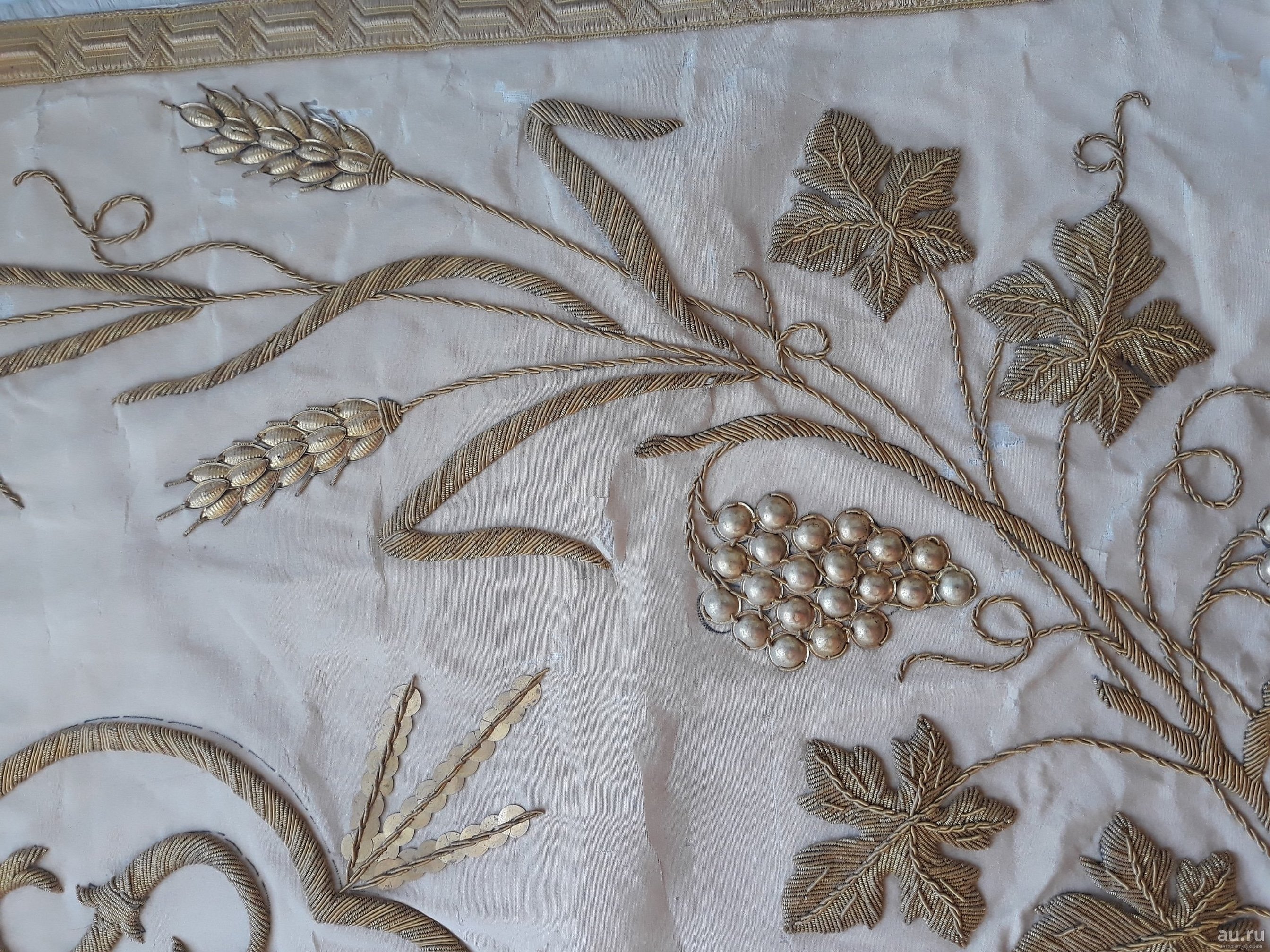
Ornaments of the Slavic peoples and their designation
Protective embroidery of the Slavs, patterns and meaning:
- Bereginya is an image of a woman with her hands down. She protects and guards the family from troubles.
- Water - in the form of a zigzag, wave, border between Yavya, Navyu. Gives immortality, carries knowledge.
- Fireweed is a talisman for an adult female organism. It protects against bad words and evil deeds.
- Spiral - speaks of wisdom. Amulet against evil forces, the evil eye.
- Stribozhich - depicts windmill blades. Protects from the elements, embroidered on work clothes.
- The woman in labor is a symbol of fertility and family well-being.

Embroidery in Russian folk costume
It is also customary to embroider ornaments on folk costumes, which has been a talisman since ancient times.
Slavic protective embroidery is mainly located in the place where the body comes into contact with the environment:
- on the edge of the sleeve;
- along the bottom of the product;
- by the gate.
It is believed that this ornament will protect a person and strengthen health.
Children also wore their parents' clothes, which symbolized the connection between generations. There are many Russian fonts for machine embroidery.
Additional information! From the age of 3, the child received the first shirt, which protected him. For example, a son receives a man's shirt.
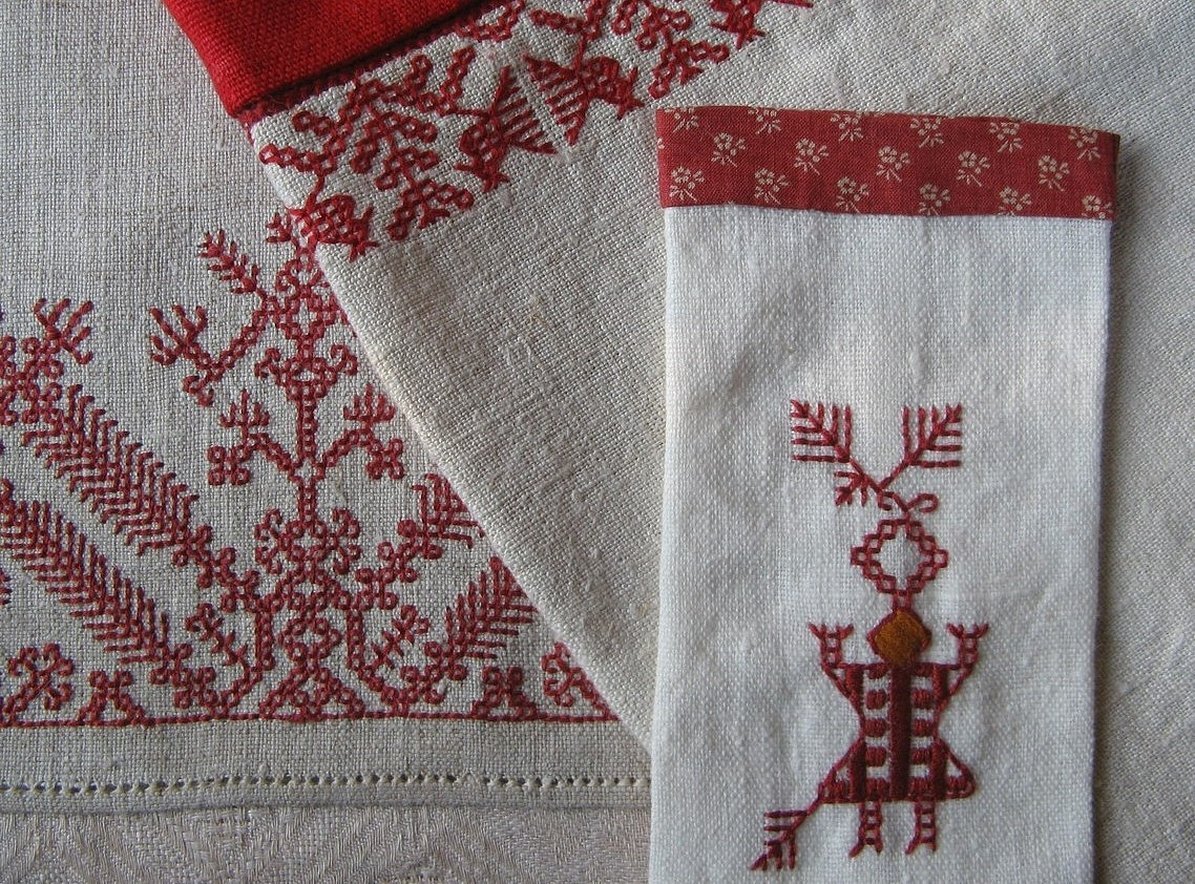
Krestetskaya stitch
Application type - openwork ornament. It has gained popularity since the 60s of the cities of the XIX century. The embroidery is done on a "broken needle" of a lace type, has a geometric pattern, is rich in decorations, variety - it differs from other types of lines.
The Krestetskaya factory has experienced several ups and downs. The Great Patriotic War, the change of power in the 90s - all affected the state of the factory. Now it has a new owner, the task is to restore the museum, which opened in 1930. It is used to decorate towels, blankets, sheets.
Features of the technique
Previously, lace was embroidered with thread pulled from the fabric. The color of the material determined the color of the ornament.
"White on white embroidery" is a short description of the stitch. In this case, linen fabric in a check is filled with a figured pattern of thin white threads. To create the stitch, longitudinal and transverse threads are pulled out, which turn the material into an openwork network. The threads are intertwined with a needle, creating a pattern.
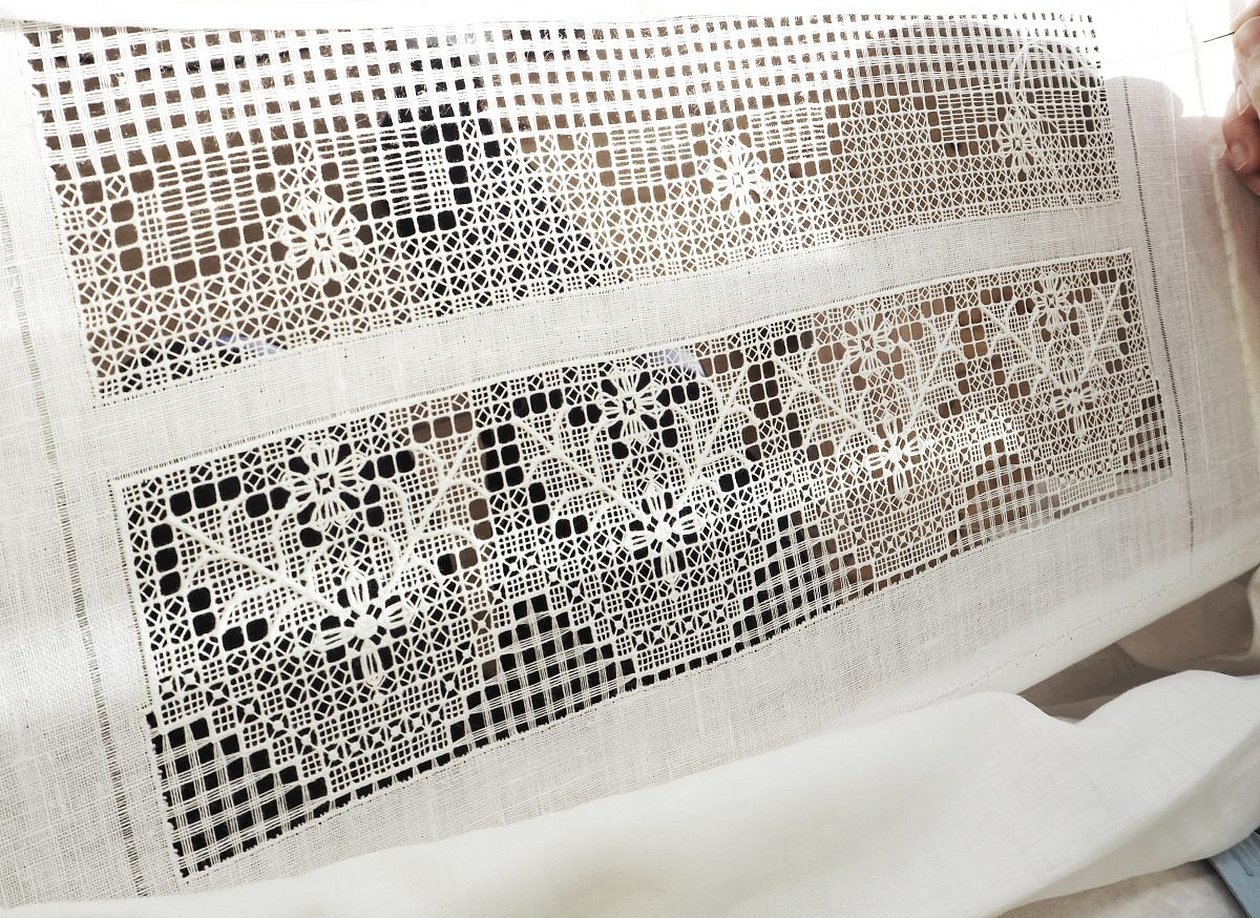
Basic rules for choosing a pattern
When choosing an ornament, you need to carefully study the meaning of the symbols, as well as the color scheme. It is also recommended to rely on the geographical location to support local craftswomen. Most often, girls prefer large patterns, while men pay attention to small symbols.
The article examines in detail the meaning and history of traditional Russian embroidery. Nowadays, embroidery is often done due to the race for fashion collections, but it is recommended to pay attention to the history of the ornament when choosing. Slavic traditions of bead embroidery will help to add attractiveness to the image.




